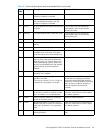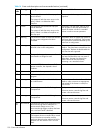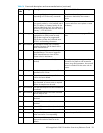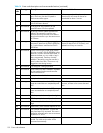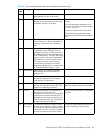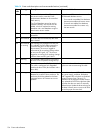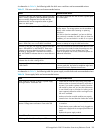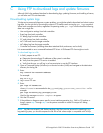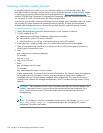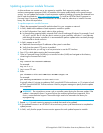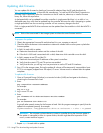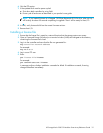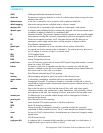
HP StorageWorks 2000 G2 Modular Smart Array Reference Guide 107
C Using FTP to download logs and update firmware
Although SMU is the preferred interface for downloading logs, updating firmware, and installing a license,
you can also use FTP to do these tasks.
Downloading system logs
To help service personnel diagnose a system problem, you might be asked to download and submit system
log data. You can do this by accessing the system’s FTP interface and running the get logs command.
When both controllers are online, regardless of operating mode, get logs will download the following
data into a single file:
• User configuration settings from both controllers
• Event logs from both controllers
• SC debug logs from both controllers
• SC crash dumps from both controllers
• MC CAPI trace from the target controller
• MC debug log from the target controller
• Controller environment (including data about attached disks, enclosures, and so forth)
It is recommended to use a command-line-based FTP client. A GUI-based FTP client might not work.
To download logs to a file
1. In SMU, prepare to use FTP:
a. Determine the network-port IP addresses of the system’s controllers.
b. Verify that the system’s FTP service is enabled.
c. Verify that the user you will log in as has permission to use the FTP interface.
2. Open a Command Prompt (Windows) or a terminal window (UNIX) and navigate to the destination
directory for the log file.
3. Enter:
ftp controller-network-address
For example:
ftp 10.1.0.9
4. Log in as an FTP user.
5. Enter:
get logs filename.txt
where filename is recommended to be yyyymmdd_ftp_system-name_controller-ID. For
example:
get logs 20080124_ftp_Storage2_A.txt
Wait for the message Transfer complete to appear.
6. Quit the FTP session.
7. If the problem to diagnose seems specific to user-interface operation (e.g., SMU or CLI crashes or
hangs), repeat step 3 through step 6 on the partner controller to collect its unique MC debug
information.
NOTE: Log files can exceed 5 MB. Before sending a log file to service personnel or attaching it to a
bug-tracking system, you should compress the file with a tool whose output is compatible with WinZip.



